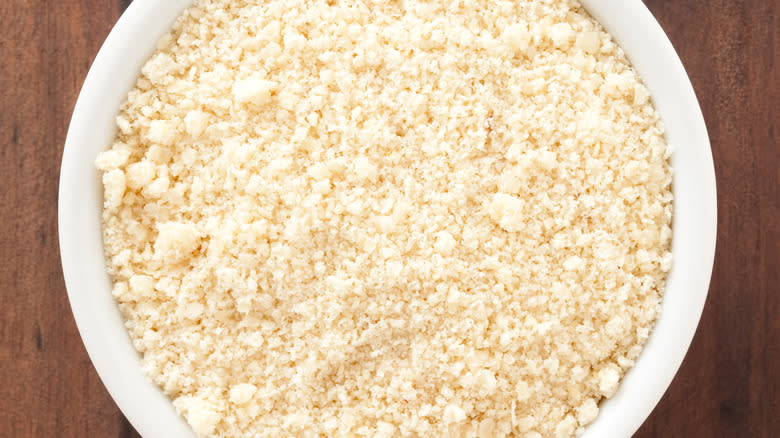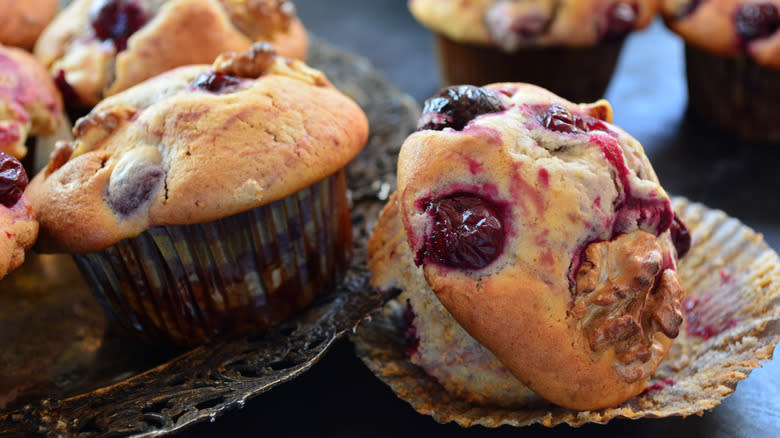The Simple Almond Flour Mistake That's Ruining Your Bakes

It's not necessary to be gluten-free in order to enjoy the delights of baking with almond flour. Its light, crumbly, and passingly sweet nutty characteristics make it perfect for almond scones, madeleines, and of course, French macarons -- but really, almost anything your baking heart desires. Regardless if you're using purpose-designed almond flour recipes or substituting almond flour for all-purpose flour, there are tips to keep in mind when baking with almond flour -- chief among them being not to over-mix your batter because doing so will result in dense and dry bakes.
Obviously, you're not trying to activate gluten by vigorous mixing or kneading an almond flour batter or dough. You really only need to mix the various ingredients by hand until they are well combined (that is to say, no more lumps or little islands of dryness), and get on with it. The longer you mix almond flour with wet ingredients, the more the almond's fats are activated -- leading to those aforementioned drier, denser bakes. The reason for this is that almond flour is not actually flour.
Read more: Cake Hacks Every Baker Will Wish They Knew Sooner
News Flash: Almond Flour Is Just Ground-Up Almonds

Almond flour is in fact nothing more than finely ground almonds, so nut flours have an exponentially higher fatty acid content than wheat flour. For example, 3.5 ounces (or 100 grams) of wheat flour contains a little less than 1.5 grams of combined mono- and polyunsaturated fatty acids. The same amount of almond flour contains 50 grams! The process of grinding nuts into a meal or flour, if continued, releases these fats and creates almond butter, and guess what -- over-mixing the flour in a cake or cookie dough will do the same thing, resulting in crumby baked goods.
Avoiding over-mixing when working with almond flour seems to be a steadfast rule no matter the recipe. Because of this, avoid operating baking machinery like a stand mixer; a sturdy spoon or spatula will do just fine. It seems that there is no benefit to overworking this flour at all -- and if your recipe calls for nut butter, you can't just mix your almond meal a little bit longer. Just put in some nut butter!
There's Good Fat, Just Like There's Good Cholesterol

About two-thirds of almond fat comes in the form of healthy monounsaturated fatty acids (as opposed to the decidedly unhealthy trans- and saturated varieties). You can substitute it 1:1 for wheat flour, or use it as a supplemental flour (try a 75% wheat flour/25% almond flour ratio) to give an added moist softness to things like muffins and pancakes. Just remember that almond flour doesn't have the same gluten structure as wheat flour, and will change the texture of your bake.
But hold on -- is it not contradictory to claim that adding almond flour as a supplement can bring moisture, while at the same time saying that over-mixing it makes a bake dry? Not if you're thinking of the source of these issues as fat and not water. A little butter, for example, will make cookies soft and moist -- while a lot of butter is needed for crumbly shortbread. As we've seen, almond flour has tons more fat than wheat flour, so adding it in as a supplement adds a moist softness as well as a richer, nuttier flavor (particularly when it browns a little -- think toasted almonds!).
Read the original article on Daily Meal

